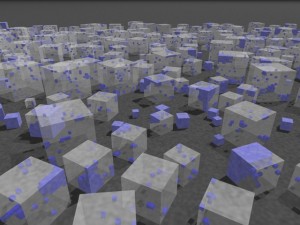Understanding what happens to a material as it undergoes phase transformations – changes from a solid to a liquid to a gas or a plasma – is of fundamental scientific interest and critical for optimizing commercial applications. For metal nanocrystals, assumptions about the size-dependence of phase transformations were made that now need to be re-evaluated.
 Palladium nanocubes interacting with hydrogen gas were directly observed through in situ luminescence to reveal that size can make a much bigger difference on phase transformations than scientists previously believed.
Palladium nanocubes interacting with hydrogen gas were directly observed through in situ luminescence to reveal that size can make a much bigger difference on phase transformations than scientists previously believed.
A team of researchers at the U.S. Department of Energy (DOE)’s Lawrence Berkeley National Laboratory (Berkeley Lab) has demonstrated that as metal nanocrystals go through phase transformations, size can make a much bigger difference than previously believed.
Working at Berkeley Lab’s Molecular Foundry, a DOE Nanoscale Science Research Center, the team led by Jeffrey Urban and Stephen Whitelam developed a unique optical probe based on luminescence that provided the first direct observations of metal nanocrystals undergoing phase transformations during reactions with hydrogen gas. Analysis of their observations revealed a surprising degree of size-dependence when it comes to such critical properties as thermodynamics and kinetics. These results hold important implications for the future design of hydrogen storage systems, catalysts, fuel cells and batteries.
“No one has ever directly observed phase transformations in metal nanocrystal systems before so no one saw the size dependence factor, which was obscured by other complicating effects, hidden in plain sight if you will,” Urban says. “The assumption had been that for nanocrystals beyond 15 nanometers, the thermodynamic and kinetic behavior would be essentially bulk-like. However, our results show that pure size effects can be understood and productively employed over a much broader range of nanocrystal sizes than previously thought.”
Urban and Whitelam, both of whom hold appointments with Berkeley Lab’s Materials Sciences Division, are the corresponding authors of a paper describing this study in the journal Nature Materials. The paper is titled “Uncovering the intrinsic size dependence of hydriding phase transformations in nanocrystals.” Co-authors are Rizia Bardhan, Lester Hedges, Cary Pint and Ali Javey.
While it is well established that materials on the nanoscale can offer physical, chemical and mechanical properties not displayed at the microscale, knowledge as to how these properties can be altered as nanocrystals undergo phase transformations has been lacking.
“Quantitative understanding of nanocrystal phase transformations has been hindered by difficulties in directly monitoring well-characterized nanoscale systems in reactive environments,” Urban says.
Urban and his colleagues addressed this problem with a custom-built stainless steel gas-tight cell with optical windows and heating elements and connected to a high vacuum pump. They used this experimental setup to collect in situ luminescence spectra with a confocal Raman microscope as palladium nanocubes interacted with hydrogen gas. The nanocubes were synthesized by wet-chemistry and were all clear-faceted single-crystalline objects with a narrow range in size distribution.
“Our experimental setup allowed for rapid, direct monitoring of minuscule alterations in luminescence during hydrogen sorption,” Urban says. “This allowed us to uncover the size-dependence of the intrinsic thermodynamics and kinetics of hydriding and dehydriding phase transformations. We observed a dramatic decrease in luminescence as the palladium nanocubes formed hydrides. This lost luminescence was regained during dehydriding.”
A statistical mechanical model whose development was led by Whitelam and co-author Hedges was then used to quantify the observational data for palladium nanocubes of all sizes. Because of the narrow size distribution of the nanocubes, Whitelam, Urban and their colleagues were able to show a direct correlation between luminescence and phase transitions that can be applied to other metal nanocrystal systems as well.
“Simple geometric arguments tell us that under certain conditions, thermally driven solid-state phase transformations are governed by nanocrystal dimensions,” Whitelam says. “These arguments further suggest ways of optimizing hydrogen storage kinetics in a variety of metal nanocrystal systems.”
The next step in this research will be to examine the effects of dopants on phase transformations in metal nanosystems.
“Our luminescence-probe and statistical mechanical model are a versatile combination,” Urban says, “that allow us to look at a number of gas-nanocrystal interactions in which controlling the thermodynamics of the interactions is paramount.”
This research was supported by DOE’s Office of Science through the Molecular Foundry and through the Center for Nanoscale Control of Geologic Carbon Dioxide, a DOE Energy Frontier Research Center. Additional support was provided by DOE’s Office of Energy Efficiency and Renewable Energy and by Mohr Davidow Ventures, a venture capital firm.